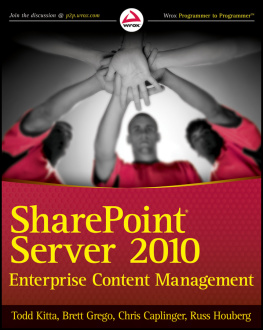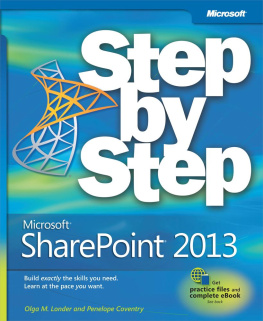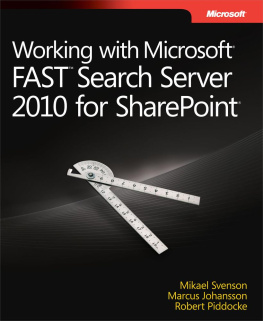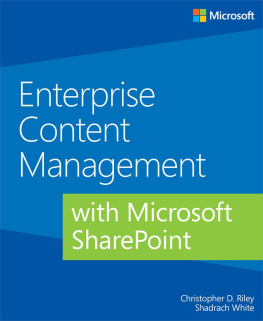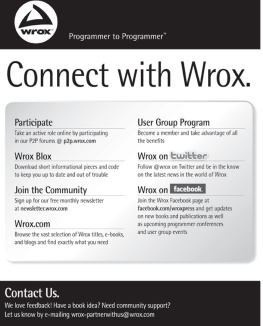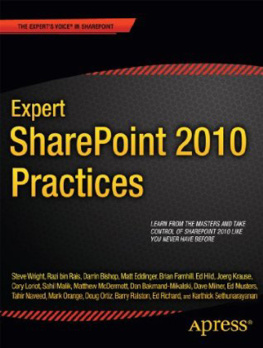Part I
Introduction to Enterprise Content Management
- Chapter 1: What Is Enterprise Content Management?
- Chapter 2: The SharePoint 2010 Platform
Chapter 1
What Is Enterprise Content Management?
What's in this chapter?
- Defining ECM as used by this book
- Gaining a historical perspective of ECM
- Defining the components of an ECM system
Considering that this is a book both by and for architects and developers, devoting an entire chapter to talking about the enterprise content management (ECM) industry and trying to define it, rather than just jumping into the bits and bytes that you probably bought the book for, might seem strange. However, by introducing ECM as part of an industry, instead of describing how the SharePoint world perceives it, we hope to provide a perspective that wouldn't otherwise be possible if you make your living inside the SharePoint ecosystem.
ECM, within or outside of the SharePoint world, seems to be a much-abused abbreviation used to describe a variety of different technologies. Of course, people often adopt new or existing terms, applying their own twist to the original meaning, and this is certainly the case with ECM. The difficult part is determining which meaning is actually correct. Sometimes even the words representing the initials are changed. For example, in the halls of our own company, sometimes electronic is used instead of enterprise. In other cases, ECM is confused with specific technologies that are part of it, such as DMS (Document Management System), IMS (Image Management System) or WCM (Web Content Management).
Clearly, ECM means a lot of different things to a variety of people. There is no doubt that some readers of this book will think something is missing from the definition, while other readers will find something included that does not fall into their own definition. That being said, this chapter introduces ECM not necessarily from a SharePoint perspective, but from a historical perspective; then it provides an overview of the components of an ECM system. You can skip this information, but we believe it is important to clarify the problems we are trying to solve, rather than just write code based on our own assumptions.
Introduction to ECM
The content aspect of enterprise content management can refer to all kinds of sources, including electronic documents, scanned images, e-mail, and web pages.
This book uses the definition of ECM from the Association for Information and Image Management (AIIM) International, which can be found on their website at www.aiim.org:
Enterprise Content Management (ECM) is the strategies, methods, and tools used to capture, manage, store, preserve, and deliver content and documents related to organizational processes. ECM tools and strategies allow the management of an organization's unstructured information, wherever that information exists.
As this definition states, ECM is not really a noun. That is, it's not something as simple as an e-mail system or a device like a scanner, but rather an entire industry for capturing and managing just about any type of content. The key to the definition is that this content is related to organizational processes, which discounts information that is simply created but never used.
Moreover, ECM is meaningless without the tools that accompany it. You might say that the tools that solve your content problem also define it. This idea is explored in the next section, and hopefully clarified by a short history of a few of the technologies involved.
A Historical Perspective
Although the term ECM is relatively new, many of the components that make up an ECM system started appearing in the 1970s. The world of information systems was vastly different 3040 years ago. The Internet as we know it did not exist, the cost to store data was astronomical compared to today, server processing power was a mere fraction of what it is today, and desktop computers didn't even exist.
The history of ECM can be traced back to several technologies that formed that first stored and managed electronic content: document imaging, electronic document management, computer output to laser disc (COLD), and of course workflow, which formed the business processes.
Document Imaging
As evidenced by the first systems to take the management and processing of documents seriously, paper was one of the first drivers. These systems were often referred to as electronic document management or document imaging systems. By scanning paper and storing it as electronic documents, organizations found a quick return on investment in several ways:
- It reduced the square footage needed to store paper.
- It resulted in faster execution of paper-based processes by electronic routing.
- It eliminated the time it took to reproduce lost documents.
- It reduced overhead because paper documents could be retrieved electronically.
In addition to a reduction in manpower, there were other benefits to storing paper electronically namely, security and risk benefits, which preceded regulations such as Health Insurance Portability and Accountability Act (HIPAA) and Sarbanes-Oxley by more than a decade. Some of these included the following:
- Password protection of documents
- Enterprise security restraint brought about by secure networks
- Management of records needed for legal holds
- Management of the document life cycle, such as retention periods
- Audit information about the document life cycle and requests about the document
The first document imaging systems for commercial consumption became available in the early 1980s, and they quickly started to replace the previous technology for removing paper from organizations, which was microfiche. Billions of documents were stored on microfiche, but indexes and location data were often stored in databases. Conversions of these systems to document imaging are surely still being handled today.
The ability to scan existing paper documents in order to create electronic documents, as discussed in the next section, led to the vision of a paperless office, a commonly used phrase by the end of the century. Of course, this lofty and often pursued goal of a paperless office has yet to materialize, and paper is still the original driver behind many business processes. As shown in , focusing on paper is a good starting point to quickly begin realizing the benefits of an ECM system.
Electronic Documents
The invention of computer-based word processors (in the 1970s) created the need for a way to store and quickly retrieve these documents. Electronic documents share similarities with document imaging systems, yet they are unique in that they are typically dynamic; that is, they often require ongoing modification, whereas scanning paper was typically performed for archiving purposes.
The first electronic documents were created through word processing software, driven in the late 1970s by WordStar and Word Perfect. Although the former has been abandoned, WordPerfect still exists today and is part of an office suite from Corel.
Soon after personal computers and electronic word processors hit the market, electronic spreadsheets became available, beginning with VisiCalc, followed by Lotus 1-2-3 and eventually Microsoft Excel. Spreadsheet documents are now as commonplace as word processing documents.
Today, electronic documents exist in countless types and formats, ranging from simple ASCII text files to complex binary structures.

